Orembai
Orembai or Arombai is a type of plank boat from the Maluku Islands of Eastern Indonesia. It is mainly used for fishing and transport. This vessel is used as far as Batavia, where in the 17th century it became popular to go out "orembaaien" on an evening rowing on the river or city canals.[1]
Etymology
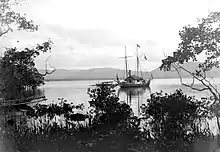
The name orembai or arumbai is probably comes from degenerated Malay word rembaya, which means state ship, with portuguese prefix 'o'.[2] In other variants of language they are also called orembaai, arambaai, arobail, arubai, arubaillo, arumbai, arumbae, oranbai, oranbaik, orang-bays, and corambay.[3][4][5] Martin says that the name orembai is a contraction for orang baik ("good man") and comes from the era of the Hongi voyages, i.e. these boats are the opposite of Hongitocht kora kora, which is a war vessel.[6]
Description
It is characterized by being equal-ended, with the prow and the stern both rising up abruptly into a sharp point about 1.26 m (4.1 ft) from the ground giving it a crescent shape. It is widest at the middle, tapering gradually towards both ends. It usually has three strakes attached to a narrow keel which in turn is joined to a stem-post at each end.[7][8] The stempost is broader and lower than the sternpost. Traditional orembai uses the tanja or lete sail, but more modern orembai adopted european-style rigging, such as pinisi rig and schooner rig.[4] Orembai is built using planks, joined with lashed-lug construction.[9]
The orembai is very similar to the mon of the North Solomons. It also resembles the kora kora, but differs in that, like most large Austronesian ships, the orembai does not have outriggers (likely due to their inherent stability).[7][8][10]
Gallery
 A "modern" orembai, West Seram, Moluccas. Before 1923.
A "modern" orembai, West Seram, Moluccas. Before 1923.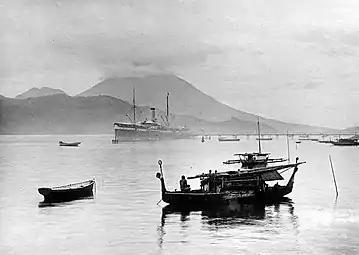 A traditional orembai with lowered sail (either a tanja or lete/crab claw sail), Ternate. Between 1910-1930
A traditional orembai with lowered sail (either a tanja or lete/crab claw sail), Ternate. Between 1910-1930 A small orembai with a crab claw sail in Rumahkay, Seram Island
A small orembai with a crab claw sail in Rumahkay, Seram Island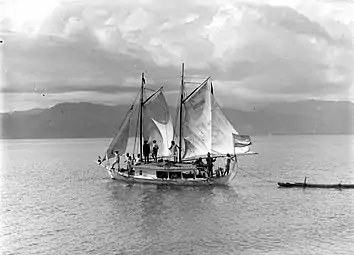 Dutch-owned orembai, Seram, Moluccas, ca. 1925
Dutch-owned orembai, Seram, Moluccas, ca. 1925
See also
References
- Kooijmans, M., and J. Schooneveld-Oosterling (2000). VOC-Glossarium: Verklaringen van Termen, Verzameld Uit de Rijks Geschiedkundige Publicatiën, Die Betrekking Hebben op de Verenigde Oost-Indische Compagnie. The Hague: Instituut voor Nederlandse Geschiedenis.CS1 maint: multiple names: authors list (link)
- Lohanda, Mona (2018). VOC Glossary Indonesia. Jakarta: Arsip Nasional Republik Indonesia and The Corts Foundation. p. 12.
- Friederici, G. "Beitrage zur Volker und Sprachenkunde von Deutsch-Neuguinea." Mitteil. aus den Deutsch. Schutzgeb., Erganzungsheft Nr. 5, 1912.
- Haddon, Alfred Cort (1920). The Outriggers of Indonesian Canoes. London: Royal Anthropological Institute of Great Britain and Ireland.
- Mahdi, Waruno (2007). Malay Words and Malay Things: Lexical Souvenirs from an Exotic Archipelago in German Publications Before 1700. Otto Harrassowitz Verlag. ISBN 9783447054928.
- Martin, K. (1903). Reisen in den Molukken. Leiden: Geologische Theil.
- Hornell, James (September 1936). "200. Boat Construction in Scandinavia and Oceania; Another Parallel in Botel Tobago". Man. 36: 145–147. doi:10.2307/2791098. JSTOR 2791098.
- Ellen, R. F. (2003). On the Edge of the Banda Zone: Past and Present in the Social Organization of a Moluccan Trading Network. University of Hawaii Press. p. 157. ISBN 9780824826765.
- Horridge, G. Adrian (1982). The Lashed-lug Boat of the Eastern Archipelagoes, the Alcina MS and the Lomblem Whaling Boats (Maritime monographs and reports). Trustees of the National Maritime Museum. ISBN 978-0905555614.
- Skinner, H.D. (1957). "Migrations of culture in South-East Asia and Indonesia". The Journal of the Polynesian Society. 66 (2): 206–207.
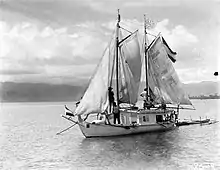
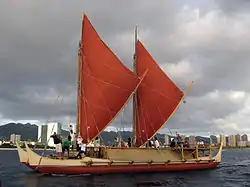
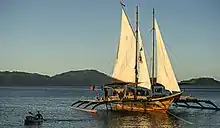
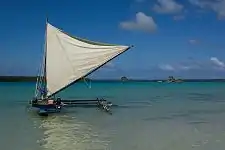
.jpg.webp)